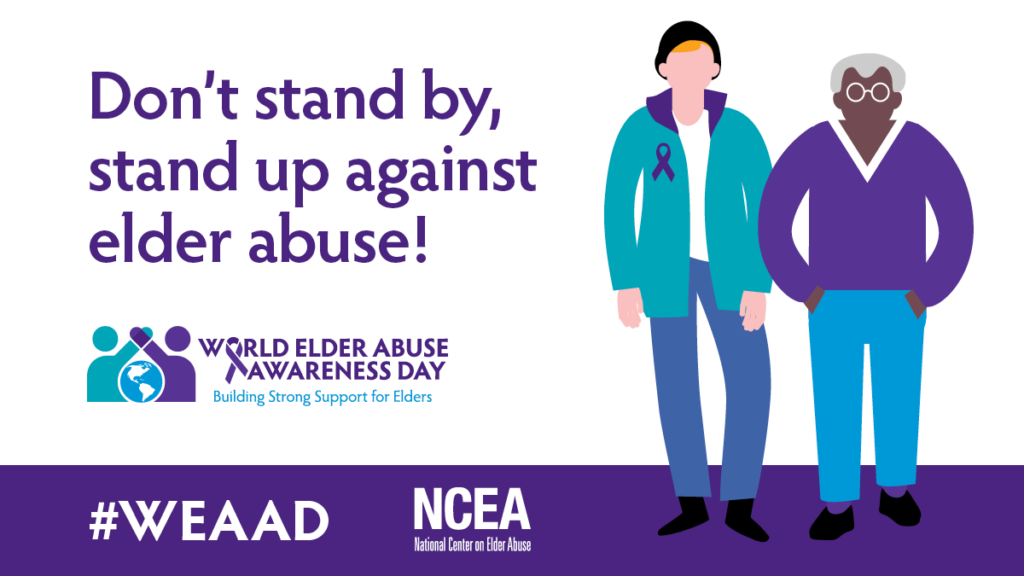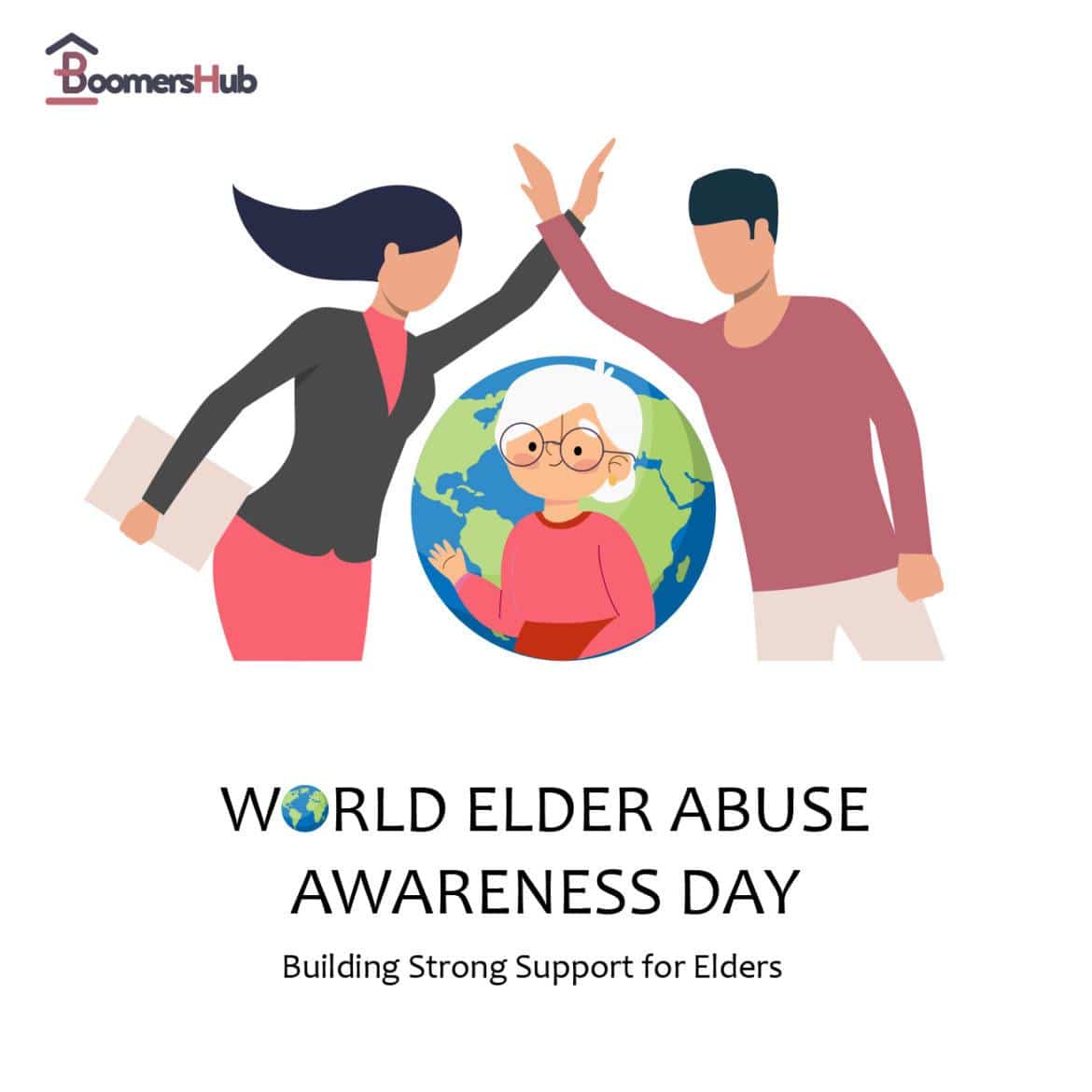About 1 in 6 people aged sixty or above all over the world have faced some form of abuse in recent years, according to the World Health Organization (WHO). Elder abuse is a global social problem affecting the Health and Human Rights of millions of seniors. The scenario is not that great in the USA either since 1 in 10 seniors (approximately 5 million older adults) are subject to abuse every year. Keeping these stats in mind, the United Nations (UN) launched the World Elder Abuse Awareness Day (WEAAD) on June 15, 2006, to raise awareness among communities worldwide to prevent elderly abuse.
The most alarming thing about elder abuse is that most abuse comes from family members or people they trust. In addition, they face mistreatment at home or in long-term care facilities such as nursing homes or assisted living. So, we must work together to protect elderly citizens and ensure a safe living environment for them.
In this blog, we will discuss World Elder Abuse Awareness Day (WEAAD) 2022, key facts about elder abuse, its types, its signs, and how we can raise awareness in the community and prevent them from happening. So, if you have a senior loved one at home or in a retirement community, make sure you check out these facts and help your elderly relative facing similar issues.
Elder Abuse Fact Sheet
Elder abuse is a pressing issue worldwide and has some data backing these concerns. Let’s take a look at some of the key facts about elder abuse:
- An estimated 5 million older adults suffer abuse every year in the USA.
- Around 10-16% of older adults experience some form of exploitation, including psychological and physical abuse.
- Elder abuse has many types, and the most common form is neglect (60%). Other forms include physical harm, emotional abuse, financial exploitation, verbal assaults, etc.
- An approximate $2.9 billion has resulted in losses due to financial abuse of older people.
- In the USA, the rate of elderly abuse was 8% in 1950, but currently, it doubled to 16.9% in 2021. Furthermore, the rate is predicted to reach 22% by 2050.
- According to a CDC report based on nonfatal assaults and homicide data during 2002-2016, men had higher rates of both types of abuse (107.8 vs. 50.4 and 3.16 vs. 1.53 respectively) compared to women.
- About 64% of staff in different care facilities have admitted to perpetrating some form of elder abuse.
- WHO suggests that at least 2 in 3 staff in nursing homes and long-term care facilities have committed abuse in 2021.
- 24.3% of nursing home residents have faced physical abuse at least once.
- According to NCBI, the COVID-19 pandemic has escalated the elder abuse rate.
- Most of the abuse is committed by trusted people like family members, friends, or caregivers.
- Only 1 in 24 elder abuse cases get reported to police or other authorities.
- Elder abuse can lead to long-term health consequences and serious physical injuries.
- The elderly population is expected to double from 2015 to 2050 and hit the 2 billion mark.
- The number of abused seniors is predicted to reach 320 million by 2050.
History of World Elder Abuse Awareness Day
The International Network for the Prevention of Elder Abuse (INPEA) initiated World Elder Abuse Awareness Day in 2006. The day was recognized as United Nations Day in resolution A/RES/66/127 by the General Assembly. All UN member states, organizations, and civil societies are invited to observe the day with appropriate importance. The WEAAD was established to raise awareness among communities and societies and promote better treatment and protection of our older citizens.
What is Elder Abuse?
In simple words, elder abuse is mistreating, neglecting, or exploiting any older individual (60 or above) by their trusted person or group of people. It can be a single incident or re-occurring issue. These acts of abuse can cause or create the risk of injuries, distress, and psychological damage to an older adult. The seven common forms of elder abuse include:
- Physical abuse (beating, pushing, slapping, burning, killing, etc.)
- Emotional abuse (verbal abuse, disrespect, threat, etc.)
- Sexual abuse (non-consensual sexual contact of any form)
- Neglect (lack of protection, negligence of personal care and hygiene, etc.)
- Abandonment (getting abandoned by family, legal guardian, or caregiver)
- Financial abuse (getting scammed, unauthorized fund transfer, forgery, improper/illegal use of any assets, etc.)
- Self-neglect (inability to perform daily tasks or take care of themselves)
Signs of Elder Abuse
Elder abuse can go unnoticed if not paid close attention to their changed behavior or appearance. So, it is crucial to understand and identify the warning signs of all forms of elder abuse. It can be life-saving for your elderly loved ones. Below are some of the signs of different types of elder abuse:
1. Physical abuse
- Bruises or blackening of any body part
- Broken bones or sprains
- Pain in joints or muscles
- High fever
- Damaged items such as eyeglasses, furniture, etc.
- Any other form of unexplained injuries
2. Emotional abuse
- Mood swings
- Self-isolation or avoiding interaction
- Crying
- Being depressed and withdrawn
- Looking sad or anxious
- Self-harm tendency
- Skipping meals, not sleeping
- Use of power and control by the spouse
3. Sexual abuse
- Unexpected sexually transmitted disease (STD)
- Bruises, pain or bleeding in genitals and private parts
- Looking anxious, disturbed, or withdrawn
- Torn/stained clothing or missing clothing items
- Inappropriate verbal or physical exchange between caregiver and the senior
4. Neglect
- Lack of medical supplies and supervision
- Bedsores, worsened condition, untreated injuries
- Lack of personal hygiene maintenance
- Malnutrition and dehydration
- Unsafe living situations such as no heating, plumbing, etc.
5. Abandonment
- Looking sad, downcast, lost, scared, or anxious
- Looking malnourished or unkept
- Depression, panic attacks
- Poor hygiene
- Withdrawals and isolation
6. Financial abuse
- Sudden change in the financial situation
- Appearing secretive or scared
- Money or other valuables missing
- Changes in legal or financial documents (e.g., wills or titles)
- Contact with suspicious parties/individuals
- Unable to access bank accounts or financial records
- Suspicious financial transactions
7. Self-neglect
- Sudden weight loss or looking frail
- Unkempt clothing and appearance
- Lack of food and medical supplies
- Poor living situation (e.g., no running water, dirty bedding)
- Substance abuse
- Chronic health situations
- Disconnected utilities
- Poor hygiene
Causes of Elder Abuse
- Understaffing: Understaffing can often lead to elder abuse. If the number of residents is significantly higher than the number of facility staff, it can lead to burnout and result in neglect and other forms of abuse.
- Lack of staff training and awareness: If the facility staff isn’t trained properly, they might lack awareness and expertise in elder care. It may lead to the mistreatment of the elderly.
- Cultural barriers: In some cases, cultural differences may lead to elder abuse. For example, in many families or cultures, caring for seniors is fundamental, while in many cultures, it is not. Cultural barriers can also cause communication gaps and lead to abuse.
- Family issues: Differences among family members can lead to various forms of elder abuse. In many families, parents and children do not share an amicable relationship. It leads to neglect, financial abuse, or even physical abuse.
- Functional dependency: As people age, they become dependent on other people to perform their daily tasks or personal care. Sometimes, people take advantage of the dependency and abuse older people for their benefit.
How to observe World Elder Abuse Awareness Day

World Elder Abuse Awareness Day 2022 is soon approaching. So, make sure you take the time to educate yourself and your elderly family members about the signs and prevention methods of elder abuse. There are several ways to observe the day alone or with your community. Here are some of the options:
Take part in a vigil or a march
Every year, local and government organizations such as the National Center on Elder Abuse organizes vigils or marches to raise awareness about elder abuse. You can participate in one of those and bring your family members or friends along. These vigils are a great way to gain public attention and generate grassroots movements.
Record short videos and take photos
You can record a short video explaining the devastating consequences of elder abuse and share it on your social media or other public platforms. You can also share these videos with your senior relatives to keep them alert. You may also take photos and send them to your elderly loved ones living in care homes to make them feel supported and loved.
Educate yourself on issues that affect the elderly
Another great way to observe WEAAD is by exploring websites, blogs, and videos discussing matters that affect senior citizens and their rights. You can also read related books and journals to understand better the signs and prevention techniques of any form of elder mistreatment. Once you know the facts, you can share them with your close circle to spread the knowledge.
Collect stories from seniors
Many older adults have powerful and intriguing life experiences and stories to share. Do not hesitate to reach out to them and interview them about their personal experiences on this matter. You can also interview senior care providers and community services and ask about the changing scenarios and perceptions of older people over the years.
Make a donation
You can make donations to different organizations that work for the betterment of senior citizens. It can be a non-profit or government organization, or a local charity. These donations can make a difference if utilized properly towards the elderly community.
5 Things Anyone Can Do to Prevent Elder Abuse
There are several ways to prevent the mistreatment of seniors from the start. We must build support and awareness to protect our elders from violence or abuse. Here are five things anyone can do to prevent elder abuse:
1. Understand and identify the signs
The first step to preventing any kind of elder abuse is to understand its nature and signs. Then, if you are aware of the signs, you can easily identify if your senior loved one has been through such trauma and take collective action against it.
2. Do not let the elderly feel alone or isolated
Do not isolate your senior relatives. Please make sure you check on them regularly and ask about their day. It will provide a sense of security and strength for the elderly. Make sure they feel comfortable sharing details of their lives with you so that they can open up about any mistreatment or distress.
3. Talk to doctors and caregivers about possible abuse
Another thing you can do is pay a visit to the family doctor and inquire about any family history of abuse or signs of past abuse in your elderly relative or loved one’s life. You can also speak with their caregivers and ask about any abnormalities in their behavior or health conditions. Once you have proper knowledge of these matters, you can take preventive actions to ensure better protection for seniors.
4. Pay regular visits to care homes and talk to the residents
If your elderly loved one lives in a senior care facility or retirement community, make sure you visit them regularly and pay close attention to their attitude, health condition, and living arrangements. Also, please get to know their fellow residents and collect information related to the facility’s services, staff behavior, and treatment of residents. That way, you can be aware of any warning signs and take necessary actions.
5. Support your senior loved ones in reporting any form of abuse
As mentioned earlier, a very low percentage of older adults report abuse to relevant authorities. It can be because of fear, anxiety, lack of support, and many other factors. So, it is crucial that you let your senior loved ones know that they are not alone. Have open conversations with them and make it known that they can share anything with you, and you will be there to support them throughout the process of demanding justice.
Elder Abuse Awareness Activities
Many people still don’t understand the severity and devastating consequences of elder abuse. So, it is vital to keep working towards raising as much public awareness as possible. Here are some easy ways to do so:
- Raise awareness among family and friends by providing information and data
- Share related videos, books, news articles, regulations, and other resources to the elderly
- Become a volunteer for a senior organization or senior center and pay regular visits
- Organize vigils and form community support groups
- Print merchandise (e.g., purple t-shirts, wristbands, hats) and distribute among communities and social platforms
- Send letters to newspapers, local agencies, and TV stations suggesting coverage of WEAAD
How Senior Facilities Can Prevent Elder Abuse
Since nursing homes and other long-term care facilities have a high rate of elder abuse, the communities must take preventive actions to stop them. Here are some steps senior care homes can take to prevent elder abuse:
Quality monitoring systems
All long-term care facilities should install strict monitoring systems to assess the quality of care provided to the residents. It will ensure the caregivers and staff take their job more seriously and refrain from performing any unethical acts.
Strong patient care policy
Strong and supportive patient care policies can play a significant role in preventing elder abuse. In addition, these policies and procedures will ensure the facility will be held accountable for any unlawful mistreatment of its residents. That way, necessary legal actions can be taken against the facility or staff in case of any such incident.
Train and educate senior living staff
Senior facilities need to ensure they hire caregivers and staff after a thorough background check and proper training. With continuous training and education on neglect and abuse issues, these communities can reduce the rate of senior maltreatment by facility staff.
Reassess caregiver situation
Caregivers work under a lot of pressure and stress, which may lead to conscious or subconscious abuse of the residents. So, senior facilities need to regularly assess their caregiver situation and see if they are overworked, facing personal or financial problems, substance abuse, etc.
Keep residents engaged and active
Senior facilities need to ensure their residents stay connected with the community and interact with fellow members. For example, they may arrange different events, fitness classes, day trips, and other engaging activities for assisted living residents so that they feel at home and supported. Forming friendships inside the facility can boost their confidence and prevent isolation.
Enable frequent visits from family or social workers
Allowing frequent visits from volunteers, social workers, or family members can reduce the risk of elder abuse in senior facilities. This way, older adults will stay connected to people, share any mishandling or neglect, and take action. It will also send the staff and administration a message that seniors are not alone and have support.
How Can BoomersHub Help Seniors?
BoomersHub believes everyone deserves to live their life with dignity and respect. We have been working tirelessly to ensure the highest quality of support and resources for the elderly. Seniors and their families can find many quality articles concerning older adults on our blog and website. Besides, BoomersHub uses social media platforms to raise awareness about senior-related topics. Our experienced family advisors work alongside seniors and their families to find the best senior living facilities that provide them with a safe and nurturing environment.
Please visit our website or get in touch by calling +(877) 409-0666 or email at info@boomershub.com to avail of our Free services!
FAQs related to Elder Abuse
- What are the categories of elder abuse?
Elder abuse has three basic categories:
- Domestic elder abuse
- Institutional elder abuse
- Self-neglect or self-abuse
- What was the theme of World Elder Abuse Awareness Day last year?
In 2021, the theme of World Elder Abuse Awareness Day was ‘Access to Justice.’
- What are the consequences of elder abuse?
Elder abuse can result in premature mortality, permanent injuries, financial crisis, mental health issues, cognitive decline, and more.
- What type of elder abuse gets reported the most?
According to the National Council on Aging (NCOA), seniors most often self-report financial abuse. Even though psychological abuse happens to be the most common form of elder abuse.
- What type of elder abuse gets reported the least?
Caregiver neglect is the least reported elder abuse as per The U.S. Justice Department.

